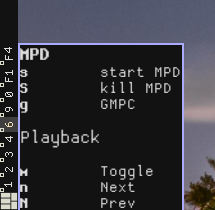modalbind allows you to create modal keybindings (similar to vim modes) in awesome. modalbind requires awesome 4.0+
To use it, you define a keymap table of bindings for a mode and
create a normal binding to enter that mode. A keymap mode table contains one
table per binding,in the form
{
-- the key like for awful.key
key,
-- function to call
action,
-- optional, shown to user while in mode
description,
-- optional, override mode-wide stay_in_mode setting. see below
stay_in_mode=true/false
}Additionally, separator elements can be added to group the actions displayed in the popup. Just add a table like the following:
{"separator", group_title } -- literal string "separator" is required.Then, bind a key to modalbind.grab{keymap=mapping_table, name="Some Title"},
to open the mode menu. modalbind.grab takes up to six named parameters:
keymap- the mapping tablename- the mode name. Optional, if not set, no box will be shown.:tay_in_mode- "Stay in the current mode" boolean. If true, awesome will stay in the input mode until escape is pressed. Defaults tofalse. Any mapping in the keymap may contain a stay_in_mode entry, which overrides this for that key only.args- additional arguments passed on to functions in the mapping table, e.g. passing the client forclientkeysbindings.layout- index of the keyboard layout, widget will automatically switch to. If two layouts are defined in the system (indexed 0 and 1), widget will switch to the chosen one upon entering input mode and restore previous layout, leaving it. When argument is not set, widget will not change the layout.case_insensitive- convert keys to lowercase befor matching.
An example mode for controlling mpd, entered by pressing Mod + m:
local mpdmap = {
{ "s", function() awful.util.spawn("mpd") end, "start MPD" },
{ "S", function() awful.util.spawn("mpd --kill") end, "kill MPD" },
{ "g", function() awful.util.spawn("gmpc") end, "GMPC" },
{ "separator", "Playback" },
{ "m", function() awful.util.spawn("mpc toggle") end, "Toggle" },
{ "n", function() awful.util.spawn("mpc next") end, "Next" },
{ "N", function() awful.util.spawn("mpc prev") end, "Prev" },
}
-- in your keybindings:
local modalbind = require("modalbind")
modalbind.init()
...
awful.key({ modkey }, "m", function() modalbind.grab{keymap=mpdmap, name="MPD", stay_in_mode=true} end),
...Pressing Mod + m now will enter the mode and display a wibox with the keys:
Note on the stay_in_mode option: When a mapping's function uses the
keygrabber itself (e.g. another call to modalbind.grab), stay_in_mode
cannot be used! If your parent mode has stay_in_mode set, disable it locally
for each key starting its own keygrabber.
Pressing any of the bound keys will call the associated function. Note that no modifier key is needed, all input goes to the mode. To pass keys to applications again, press Esc to leave the mode.
The third parameter to modalbind.grab determines, if input will stay in the mode
after a bound key other than Escape is pressed. In the mpd example, input stays
in mpd mode, so that pressing n several times for skipping a few
songs is possible. If the parameter is set to false, the mode acts like a menu,
closing after an action is chosen.
You can configure binding defaults that apply to all modes with modalbind.default_keys. The default keybindings are Escape and Return as shown.
modalbind.default_keys = {
{"separator", "mode control" },
{"Escape", modalbind.close_box, "Close Modal"},
{"Return", modalbind.close_box, "Close Modal"}
}Put this repository somewhere in the lua search path for awesome. If your awesome configuration is managed by git, I recommend adding this repo as a git submodule:
git submodule add https://github.com/crater2150/awesome-modalbind.git modalbind
Then, in your rc.lua:
local modalbind = require("modalbind")
modalbind.init()The position and contents of the wibox can be configured:
modalbind.set_location(position) sets the location of the wibox
displaying the mode and the bindings. Acceptable values of the position
argument are "top_left", "top", "top_right" e.t.c. Full list of
acceptable positions can be found
here.
Additionally, location offset can be added via set_x_offset(amount) /
set_y_offset(amount). The wibox is moved the given amount of pixels to the
bottom right. Negative offset values are allowed.
With show_options() and hide_options() you can enable or disable showing all
bindings in the box. If disabled, the wibox will only display the name of the
current mode. With show_default_options() and hide_default_options() you can
control if the shown bindings should include bindings from default_keys.
Theming is done via beautiful, the wibox uses default colors and the border color for focused windows. You can override this with these theme keys:
theme.modalbind_font = "Monospace 9" -- font
theme.modebox_fg = "#AABBCC" -- foreground
theme.modebox_bg = "#DDEEFF" -- background
theme.modebox_border = "#112233" -- border color
theme.modebox_border_width = 1 -- border widthYou can change the opacity of the box with modalbind.set_opacity(opacity),
where opacity is a float between 0.0 and 1.0.
